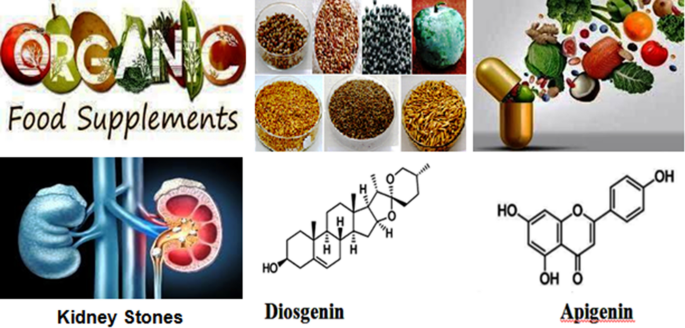Study on nutritional and phytochemical profile of seven edible food supplements of Uttarakhand (Garhwal Himalaya)
Research Articles | Published: 25 June, 2021
First Page: 678
Last Page: 683
Views: 3985
Keywords: Anticancer activity, Anti-diabetic activity, Anti-nephrolithiasis, Grains, Tor- C. indicus , Gahat- D. biflorus , Kala bhat- G. soja , Bhujaila- B. cerifera , Koni- S. italica , Jakhya- C. viscos
Abstract
Medicinal plants are the potential sources of different natural molecules having wide pharmacological activities. The fruits and parts of these plants are also the sources of significant antioxidants and nutraceuticals having potent antioxidant potential and significant immuno-modulatory activities. The present study is the first report on wild edible food supplements that are endowed with various medicinal properties and significant antidiabetic, anticancer and anti-nephrolithiasis properties. The study was performed to determine the nutritional, mineral profile and phytochemical analysis of seven (7) medicinal plants viz. Cajanus indicus, Dolichos biflorus, Glycine soja, Benincasa cerifera, Setaria italica, Cleome viscosa and Hordeum vulgare for exploring and development of new, safe and potent drugs. The extraction was performed by fractionation with different solvents, while the nutrients and minerals present in all these plants were studied using Association of Official Analytical Chemists (AOAC) method and Inductively coupled plasma-mass-spectrometry (ICP-MS) techniques. The results of the study revealed the presence of significant nutrients and minerals in all the seven (7) plants studied. The present study revealed that, carbohydrates/glycosides were present in Cajanus indicus, Dolichos biflorus, Glycine soja, Benincasa cerifera, Setaria italica, Cleome viscosa and Hordeum vulgare while alkaloids were observed by Mayer’s test only in Cajanus indicus, Dolichos biflorus and Glycine soja. The flavonoids were observed in Cajanus indicus, Glycine soja, Benincasa cerifera, Cleome viscosa and Hordeum vulgare. The saponins were observed in Cajanus indicus, Glycine soja, Benincasa cerifera, Setaria italica and Hordeum vulgare. The tannins were observed as pyrogallol and catechol in Cajanus indicus, Glycine soja, Benincasa cerifera and Cleome viscosa. The unsaturated sterol and triterpene were observed by Liebermann Burchard test and Salkowski test in all the seven plants studied. The varied levels of mineral content were observed in Cajanus indicus, Dolichos biflorus, Glycine soja, Benincasa cerifera, Setaria italica, Cleome viscosa and Hordeum vulgare. The nutritional value of Cajanus indicus, Dolichos biflorus, Glycine soja, Benincasa cerifera, Setaria italica, Cleome viscosa and Hordeum vulgare.
Graphic abstract


References
- Al-Snafi AE (2013) The pharmacological importance of Benincasa hispida. A Review. Int J Pharm Sci Res 4(12):165–170
- Amaaniand R, Dwira S (2018) Phytochemical content and in vitro toxicity of Glycine soja ethanol extract on the A549 Lung cancer line cell, The 2nd Physics and Technologies in Medicine and Dentistry Symposium. IOP: Journal of Physics: Conf. Series, 1073
- AOAC (2000) Official methods of analysis of AOAC Int., 17th edn. AOAC Int., Arlington
- Chandra S, Saklani S, Semwal RB (2019) Estimation of nutritional and mineral contents of E. coracana and E. frumentacea- two edible wild crops of India. Curr Nutr Food Sci 15(4):363–366
- Dasgupta T, Saikat KP (2016) Anti-inflammatory and Neuropharmacological activities of the seed extract of Setaria italica. J Appl Pharm Sci 6(5):193–197
- Gupta SK, Sharma PK (2005) Review on phytochemical and pharmacological aspects of D. biflorus Linn. Asian J Chem 17(1):37–39
- Iswaran VA (1980) Laboratory handbook for agricultural analysis. New Delhi Today and Tomorrow’s Printers and Publisher, pp 209–222
- Kokate CK, Purohit AP, Gokhale SB (2005) Pharmacognosy, 33rd edn. Nirali Prakashan, pp 107–109
- Mali RG (2010) Cleome viscosa (wild mustard): a review on ethnobotany, phytochemistry, and pharmacology. Pharm Biol 48(1):105–112
- Nene YL, Sheila VK (1990) Pigeon pea: geography and importance. In: Nene YL, Hall SH, Sheila VK (eds) The pigeon pea. CAB International, Wallingford, pp 1–14
- NIN (2009) Nutrient requirements and recommended dietary allowances for Indians—a report of the Expert Group of the Indian Council of Medical Research. National Institute of Nutrition (ICMR), Hyderabad
- Parrotta JA (2001) Healing plants of Peninsular India. CABI Publishing, New York, p 917
- Saklani S, Chandra S, Abhay PM (2012) Nutritional Evaluation, Antimicrobial activity and Phytochemical Screening of Wild edible fruit of Myrica nagi pulp. Int J Pharm Pharm Sci 4(3):407–411
Author Information
Department of Pharmaceutical Chemistry, School of Sciences, HNB Garhwal University (A Central) University Srinagar Garhwal, Srinagar, India